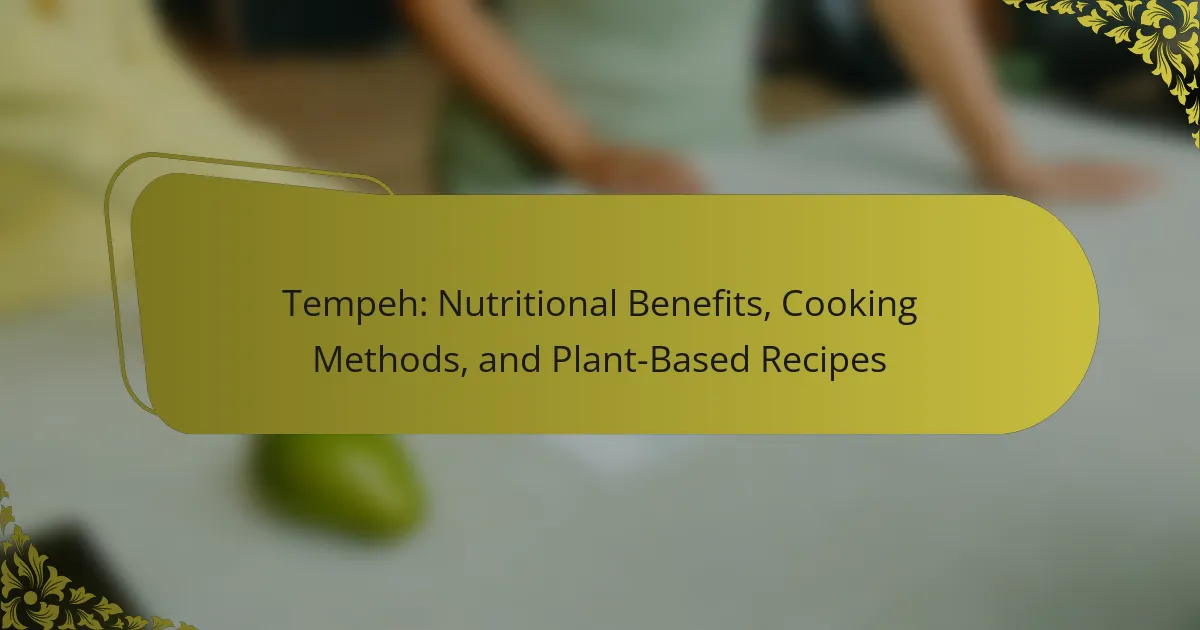Tempeh is a nutritious plant-based protein that offers numerous health benefits. This article explores its high protein content, various cooking methods, and creative plant-based recipes. Discover how to incorporate tempeh into your meals while enhancing its flavour and texture. Learn to overcome common misconceptions and enjoy this versatile ingredient in your diet.

What are the nutritional benefits of tempeh?
Tempeh offers numerous nutritional benefits, including high protein content, dietary fibre, and essential vitamins. It contains about 31 grams of protein per 100 grams, making it an excellent meat alternative. Tempeh is rich in probiotics, which support gut health, and is a good source of iron and calcium. Additionally, it is low in saturated fat, contributing to heart health.
How does tempeh compare to other plant-based proteins?
Tempeh offers superior protein content compared to many other plant-based proteins. It contains approximately 31 grams of protein per 100 grams, making it a robust option for those seeking plant-derived protein sources.
In comparison to tofu, which has around 8 grams of protein per 100 grams, tempeh stands out due to its fermentation process that enhances nutrient absorption. Additionally, tempeh is rich in dietary fibre and contains essential amino acids, contributing to its unique nutritional profile.
When comparing tempeh to legumes, such as lentils, which provide about 9 grams of protein per 100 grams, tempeh remains a more concentrated protein source. This makes tempeh a valuable addition to plant-based diets, particularly for individuals looking to increase their protein intake without animal products.
Overall, tempeh’s high protein content, fibre, and unique fermentation benefits distinguish it from other plant-based proteins, making it a preferred choice for health-conscious consumers.
Which vitamins and minerals are abundant in tempeh?
Tempeh is rich in several vitamins and minerals, including vitamin B2 (riboflavin), vitamin B3 (niacin), vitamin B6, folate, iron, magnesium, and phosphorus. These nutrients contribute to its health benefits and nutritional profile. Tempeh’s fermentation process enhances nutrient absorption, making it a valuable plant-based protein source.
What are the health benefits associated with consuming tempeh?
Tempeh offers numerous health benefits, including high protein content, digestive support, and heart health improvement. It is rich in probiotics, which enhance gut health. Additionally, tempeh is a good source of vitamins and minerals, such as calcium and iron, contributing to overall nutritional well-being. Its fermentation process increases nutrient absorption and provides unique flavours, making it a versatile ingredient in plant-based diets.
How does the fermentation process enhance tempeh’s nutritional value?
Fermentation significantly boosts tempeh’s nutritional value by enhancing protein digestibility and increasing levels of vitamins and minerals. During fermentation, beneficial bacteria break down complex compounds, making nutrients more accessible. This process also produces probiotics, which support gut health. Additionally, fermentation reduces antinutrients like phytic acid, allowing for better mineral absorption. Overall, these changes make tempeh a highly nutritious plant-based protein source.

What are the best cooking methods for tempeh?
The best cooking methods for tempeh include steaming, sautéing, grilling, baking, and frying. Each method enhances tempeh’s nutty flavour and improves its texture.
Steaming retains moisture and softens tempeh, making it easier to absorb marinades. Sautéing and frying create a crispy exterior while keeping the inside tender. Grilling adds a smoky flavour, and baking allows for even cooking and versatility in dishes.
These methods can be combined with various marinades to elevate the taste, making tempeh a delicious plant-based protein option.
How can you prepare tempeh for optimal flavour and texture?
To prepare tempeh for optimal flavour and texture, marinating and proper cooking methods are essential. Start by slicing tempeh into desired shapes, then marinate it for at least 30 minutes using ingredients like soy sauce, garlic, and ginger. This enhances the flavour profile.
Next, steam the tempeh for about 10 minutes to improve its texture, making it more absorbent and tender. After steaming, you can grill, sauté, or bake it. Grilling adds a smoky flavour, while sautéing with vegetables creates a well-rounded dish. Baking at 190°C for 20-25 minutes achieves a crispy exterior.
Experimenting with different marinades and cooking techniques can yield unique flavours, making tempeh a versatile addition to plant-based recipes.
What are popular marinating techniques for tempeh?
Popular marinating techniques for tempeh include using soy sauce, vinegar, citrus juices, and spices. These methods enhance tempeh’s flavour and texture. Marinades can be applied through soaking, brushing, or overnight refrigeration for optimal absorption. Common combinations feature garlic, ginger, and sesame oil for a savoury profile.
Which cooking methods preserve tempeh’s nutritional benefits?
Steaming and sautéing are the best cooking methods to preserve tempeh’s nutritional benefits. These techniques maintain its protein content and essential nutrients while minimising nutrient loss. Baking and grilling can also be effective but may lead to slight nutrient degradation. Cooking tempeh at lower temperatures for shorter durations helps retain its health-promoting properties.
How can tempeh be incorporated into various cuisines?
Tempeh can be incorporated into various cuisines by using it as a meat substitute, protein source, or flavour enhancer. In Asian dishes, tempeh can be stir-fried with vegetables and soy sauce. In Mexican cuisine, it works well in tacos or burritos, seasoned with spices. For Mediterranean meals, tempeh can be marinated and grilled, served in salads or wraps. In American cooking, it can be used in burgers or BBQ dishes. Its unique nutty flavour and firm texture make it versatile across these culinary traditions.

What are some creative plant-based recipes featuring tempeh?
Tempeh can be creatively used in various plant-based recipes. Here are some ideas to inspire your cooking:
1. Tempeh Stir-Fry: Sauté tempeh with mixed vegetables and a soy sauce-based marinade for a quick, flavourful meal.
2. Tempeh Tacos: Crumble tempeh and season with taco spices, then serve in corn tortillas with fresh toppings.
3. Tempeh Salad: Marinate tempeh cubes and toss them in a salad with greens, nuts, and a tangy dressing.
4. Tempeh Burgers: Blend tempeh with beans and spices to create hearty burger patties, perfect for grilling.
5. Tempeh Curry: Simmer tempeh in coconut milk and curry paste with vegetables for a rich, comforting dish.
6. Tempeh Skewers: Grill marinated tempeh on skewers with bell peppers and onions for a delicious appetizer.
Which tempeh recipes are easy for beginners?
Tempeh recipes that are easy for beginners include stir-fried tempeh, tempeh tacos, and tempeh salad. These dishes require minimal ingredients and simple cooking techniques, making them accessible for novice cooks.
1. Stir-fried tempeh: Cut tempeh into cubes, sauté with vegetables and soy sauce.
2. Tempeh tacos: Crumble tempeh, season with taco spices, and serve in taco shells.
3. Tempeh salad: Marinate tempeh, grill or bake, and toss with greens and dressing.
4. Tempeh sandwiches: Slice and grill tempeh, add to bread with toppings.
5. Tempeh curry: Cook tempeh in coconut milk with curry spices and vegetables.
How can tempeh be used in traditional dishes?
Tempeh can be used in traditional dishes by incorporating it into stir-fries, soups, and salads. Its firm texture allows it to absorb flavours well, making it ideal for marinating. For example, tempeh can replace meat in dishes like curry or tacos, providing a protein-rich alternative. Additionally, it can be crumbled into sauces or used as a filling for dumplings, enhancing both taste and nutritional value.
What are innovative tempeh recipes for advanced cooks?
Advanced cooks can explore innovative tempeh recipes that highlight its versatility. Consider these unique options:
1. Tempeh Bolognese: Replace ground meat with finely chopped tempeh for a hearty sauce.
2. Tempeh Tacos: Season crumbled tempeh with spices and serve in corn tortillas with fresh toppings.
3. Tempeh Satay: Marinate tempeh in a peanut sauce and grill for a flavourful appetizer.
4. Tempeh Stir-Fry: Combine tempeh with seasonal vegetables and a savoury sauce for a quick meal.
5. Tempeh Ramen: Add marinated tempeh to a rich broth with noodles and vegetables for a satisfying dish.
6. Tempeh Burgers: Blend tempeh with beans and spices to form patties, then grill or pan-fry.
These recipes utilise tempeh’s unique ability to absorb flavours, making them perfect for advanced culinary experimentation.
How can tempeh be used in meal prep for the week?
Tempeh can be used in meal prep by marinating, cooking in bulk, and incorporating it into various dishes. Start by slicing tempeh and marinating it in sauces like soy or teriyaki for enhanced flavour. Cook large batches by steaming or sautéing, then store in airtight containers. Use tempeh in salads, stir-fries, or grain bowls throughout the week. Its high protein content (approximately 19 grams per 100 grams) makes it a nutritious addition.

What are the common misconceptions about tempeh?
Tempeh is often misunderstood as being unhealthy or difficult to prepare. Many believe it has a strong flavour, but it actually has a nutty taste that can complement various dishes. Some think tempeh is the same as tofu; however, tempeh is fermented and contains more protein and fibre. Others assume it is only suitable for vegan diets, while it can be enjoyed by anyone seeking nutritious options. Additionally, misconceptions about its preparation lead people to avoid it, despite its versatility in cooking methods such as grilling, sautéing, or adding to soups and salads.
Why do some people avoid tempeh despite its benefits?
Some people avoid tempeh due to its strong flavour and texture. Others may have concerns about soy allergies or digestive issues. Additionally, unfamiliarity with cooking methods can deter individuals from trying it. Tempeh’s unique fermentation process, while beneficial for nutrition, can be off-putting to some.
What are the differences between tempeh and tofu?
Tempeh contains more protein and fibre than tofu, while tofu is lower in calories and fat. Tempeh is fermented, offering probiotics, whereas tofu is made from soy milk. Both provide essential amino acids, but tempeh has a nuttier flavour and firmer texture, making it suitable for grilling or stir-frying. Tofu is versatile and absorbs flavours well, ideal for soups and smoothies.
How can you address common cooking challenges with tempeh?
To address common cooking challenges with tempeh, marinate it to enhance flavour and moisture. Use precise slicing techniques for even cooking. Steam or sauté before grilling to improve texture. Incorporate tempeh into stir-fries or salads for versatility.

What are expert tips for maximizing the use of tempeh in your diet?
To maximize tempeh in your diet, incorporate it into meals in versatile ways. First, try marinating tempeh to enhance its flavour; use soy sauce, garlic, or spices. Second, add it to stir-fries for a protein boost alongside vegetables. Third, blend it into smoothies for added nutrition without altering taste. Fourth, use crumbled tempeh as a meat substitute in tacos or salads. Lastly, experiment with baking or grilling for different textures and flavours. These methods highlight tempeh’s unique attributes, such as its high protein content and ability to absorb flavours.
How can you store tempeh to maintain its freshness?
To maintain tempeh’s freshness, store it in an airtight container in the refrigerator. This method preserves its texture and flavour for up to one week. For longer storage, consider freezing tempeh, which can extend its shelf life to several months. Always defrost in the refrigerator before use to retain quality.
What are the best practices for introducing tempeh to picky eaters?
To successfully introduce tempeh to picky eaters, focus on familiar flavours and gradual integration. Start by incorporating tempeh into dishes they already enjoy, such as stir-fries or tacos, where its texture can blend in.
Marinating tempeh in favourite sauces can enhance its taste and appeal. Gradually increase the amount of tempeh in recipes over time, allowing them to adjust to the flavour.
Offering tempeh in various forms, such as crumbled or sliced, can also help in finding the preferred texture. Highlight its nutritional benefits, like protein content and probiotics, to encourage acceptance.
Which common mistakes should be avoided when cooking tempeh?
Avoiding common mistakes when cooking tempeh enhances its flavour and texture. Key mistakes include skipping marination, overcooking, neglecting to press excess moisture, and using insufficient seasoning. Marinating tempeh allows it to absorb flavours, while pressing removes excess moisture for better texture. Overcooking can lead to a dry product, and inadequate seasoning results in bland dishes. By addressing these aspects, you can improve your tempeh cooking experience significantly.
